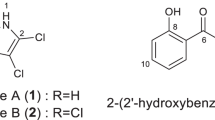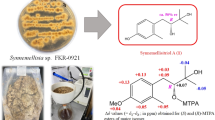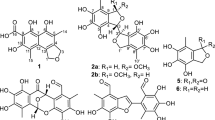Abstract
Microbispofurans A–C (1–3), new alkyl/alkenyl furancarboxylic acids, were isolated from the culture extract of the plant root-derived Microbispora sp. RD004716. The planar structures of 1–3 were determined by extensive analysis of 1D and 2D NMR spectroscopic data. Although 1–3 showed no appreciable antimicrobial activity or cytotoxicity, strong plant growth-promotion activity of the germinated red leaf lettuce seeds was observed at 10 μM. Furancarboxylic acids and their methyl esters were found in actinomycetes and fungi; however, the isolation of furandicarboxylic acid was unprecedented.
This is a preview of subscription content, access via your institution
Access options
Subscribe to this journal
Receive 12 print issues and online access
$259.00 per year
only $21.58 per issue
Buy this article
- Purchase on Springer Link
- Instant access to full article PDF
Prices may be subject to local taxes which are calculated during checkout



Similar content being viewed by others
References
Ramachandra M, Crawford DL, Hertel G. Characterization of an extracellular lignin peroxidase of the lignocellulolytic actinomycete Streptomyces viridosporus. Appl Environ Microbiol. 1988;54:3057–63.
Wilson DB. Biochemistry and genetics of actinomycete cellulases. Crit Rev Biotechnol. 1992;12:45–63.
Niladevi KN, Prema P. Mangrove Actinomycetes as the source of ligninolytic enzymes. Actinomycetologica. 2005;19:40–7.
McCarthy AJ. Lignocellulose-degrading actinomycetes. FEMS Microbiol Lett. 2006;46:145–63.
Brzezinska MS, Jankiewicz U, Walczak M. Biodegradation of chitinous substances and chitinase production by the soil actinomycete Streptomyces rimosus. Int Biodeterior Biodegrad. 2013;84:104–10.
Banik S, Dey BK. Available phosphate content of an alluvial soil as influenced by inoculation of some isolated phosphate-solubilizing micro-organisms. Plant Soil. 1982;69:353–64.
Hamdali H, Bouizgarne B, Hafidi M, Lebrihi A, Virolle MJ, Ouhdouch Y. Screening for rock phosphate solubilizing actinomycetes from Moroccan phosphate mines. Appl Soil Ecol. 2008;38:12–9.
Alori ET, Glick BR, Babalola OO. Microbial phosphorus solubilization and its potential for use in sustainable agriculture. Front Microbiol. 2017;8:1–8.
Igarashi Y, Iida T, Yoshida R, Furumai T. Pteridic acids A and B, novel plant growth promoters with auxin-like activity from Streptomyces hygroscopicus TP-A0451. J Antibiot. 2002;55:764–7.
Khamna S, Yokota A, Lumyong S. Actinomycetes isolated from medicinal plant rhizosphere soils: Diversity and screening of antifungal compounds, indole-3-acetic acid and siderophore production. World J Microbiol Biotechnol. 2009;25:649–55.
Sreevidya M, Gopalakrishnan S, Kudapa H, Varshney RK. Exploring plant growth-promotion actinomycetes from vermicompost and rhizosphere soil for yield enhancement in chickpea. Braz J Microbiol. 2016;47:85–95.
Lu S, Harunari E, Oku N, Igarashi Y, Trehangelin E. a bisacyl trehalose with plant growth promoting activity from a rare actinomycete Polymorphospora sp. RD064483. J Antibiot. 2022;75:296–300.
Shutsrirung A, Chromkaew Y, Pathom-Aree W, Choonluchanon S, Boonkerd N. Diversity of endophytic actinomycetes in mandarin grown in northern Thailand, their phytohormone production potential and plant growth promoting activity. Soil Sci Plant Nutr. 2013;59:322–30.
Goudjal Y, Toumatia O, Sabaou N, Barakate M, Mathieu F, Zitouni A. Endophytic actinomycetes from spontaneous plants of Algerian Sahara: Indole-3-acetic acid production and tomato plants growth promoting activity. World J Microbiol Biotechnol. 2013;29:1821–9.
Verma VC, Singh SK, Prakash S. Bio-control and plant growth promotion potential of siderophore producing endophytic Streptomyces from Azadirachta indica A. Juss. J Basic Microbiol. 2011;51:550–6.
Goudjal Y, Toumatia O, Yekkour A, Sabaou N, Mathieu F, Zitouni A. Biocontrol of Rhizoctonia solani damping-off and promotion of tomato plant growth by endophytic actinomycetes isolated from native plants of Algerian Sahara. Microbiol Res. 2014;169:59–65.
Janso JE, Carter GT. Biosynthetic potential of phylogenetically unique endophytic actinomycetes from tropical plants. Appl Environ Microbiol. 2010;76:4377–86.
Matsumoto A, Takahashi Y. Endophytic actinomycetes: Promising source of novel bioactive compounds. J Antibiot. 2017;70:514–9.
Indananda C, Igarashi Y, Ikeda M, Oikawa T, Thamchaipenet A. Linfuranone A, a new polyketide from plant-derived Microbispora sp. GMKU 363. J Antibiot. 2013;66:675–7.
Araújo JM, de, Silva AC, da, Azevedo JL. Isolation of endophytic actinomycetes from roots and leaves of maize (Zea mays L.). Braz Arch Biol Technol. 2000;43:447–51.
Kim SH, Shin Y, Lee SH, et al. Salternamides A-D from a halophilic Streptomyces sp. actinobacterium. J Nat Prod. 2015;78:836–43.
Greule A, Marolt M, Deubel D, et al. Wide distribution of foxicin biosynthetic gene clusters in Streptomyces strains - an unusual secondary metabolite with various properties. Front Microbiol. 2017;8:221.
Wilkins K, Schöller C. Volatile organic metabolites from selected Streptomyces strains. Actinomycetologica. 2009;23:27–33.
Citron CA, Rabe P, Dickschat JS. The scent of bacteria: Headspace analysis for the discovery of natural products. J Nat Prod. 2012;75:1765–76.
Groenhagen U, Leandrini De Oliveira AL, Fielding E, Moore BS, Schulz S. Coupled biosynthesis of volatiles and salinosporamide A in Salinispora tropica. ChemBioChem 2016;17:1978–85.
Jadulco R, Proksch P, Wray V, Sudarsono, Berg A, Gräfe U. New macrolides and furan carboxylic acid derivative from the sponge-derived fungus Cladosporium herbarum. J Nat Prod. 2001;64:527–30.
Wu J, Uchida K, Ridwan AY, et al. Erinachromanes A and B and erinaphenol A from the Culture Broth of Hericium erinaceus. J Agric Food Chem. 2019;67:3134–9.
Thiyagarajan S, Vogelzang W, JI Knoop R, Frissen AE, Van Haveren J, Van Es DS. Biobased furandicarboxylic acids (FDCAs): Effects of isomeric substitution on polyester synthesis and properties. Green Chem. 2014;16:1957–66.
Sharma AR, Harunari E, Oku N, Matsuura N, Trianto A, Igarashi Y. Two antibacterial and PPARα/γ-agonistic unsaturated keto fatty acids from a coral-associated actinomycete of the genus Micrococcus. Beilstein J Org Chem. 2020;16:297–304.
Takahashi N, editor. Shokubutsu-kagaku-chosetsu-jikkenho (Experimental Protocols for Chemical Regulation of Plants). The Japanese Society for Chemical Regulation of Plants; 1989. p. 140−1 (in Japanese).
Acknowledgements
P388 cells were obtained from JCRB Cell Bank under accession code JCRB0017 (Lot. 06252002).
Author information
Authors and Affiliations
Corresponding author
Ethics declarations
Conflict of interest
The authors declare no competing interests.
Additional information
Publisher’s note Springer Nature remains neutral with regard to jurisdictional claims in published maps and institutional affiliations.
Supplementary information
Rights and permissions
Springer Nature or its licensor (e.g. a society or other partner) holds exclusive rights to this article under a publishing agreement with the author(s) or other rightsholder(s); author self-archiving of the accepted manuscript version of this article is solely governed by the terms of such publishing agreement and applicable law.
About this article
Cite this article
Harunari, E., Mae, S. & Igarashi, Y. Microbispofurans A–C, plant growth-promoting furancarboxylic acids from plant root-derived Microbispora sp.. J Antibiot 76, 392–396 (2023). https://doi.org/10.1038/s41429-023-00614-1
Received:
Revised:
Accepted:
Published:
Issue Date:
DOI: https://doi.org/10.1038/s41429-023-00614-1



